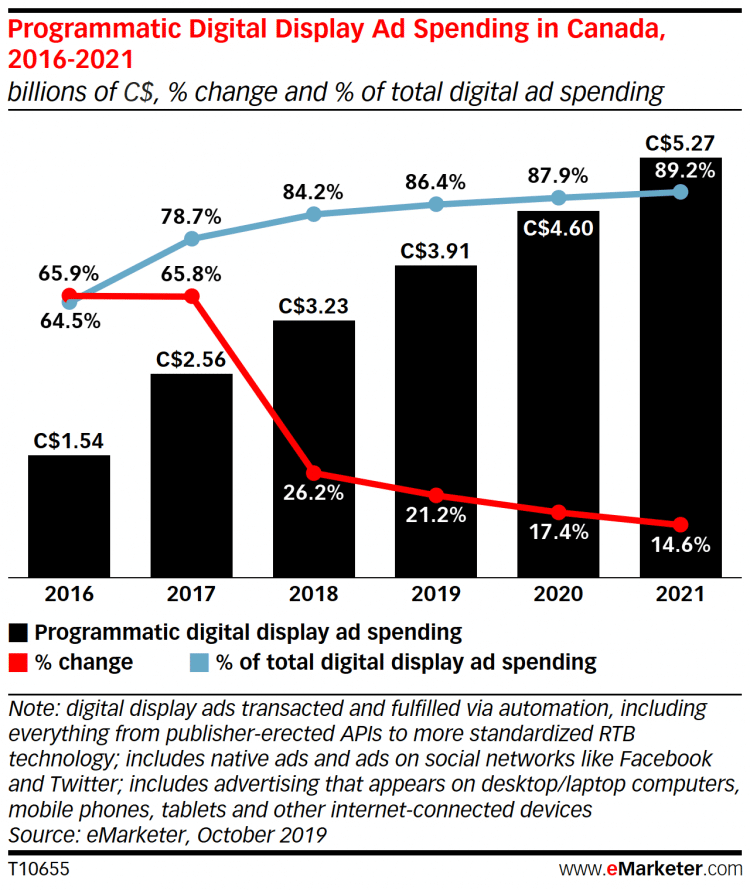Media Senior Director, Partner
Programmatic buying: the ride is over
Media Senior Director, Partner
Banner advertising has undergone great changes in recent years. Here is an inventory and potential avenues for the future.
Banner advertising, commonly known as display advertising , has gone through great changes since its inception. Indeed, the advent of programmatic at the turn of the 2010s shaped the way advertisers and agencies bought, managed, optimized and measured this medium. On the publisher side, the impact was felt on their business model and methods of monetizing their sites. As for the user, it is their digital experience that has been most affected. In short, this support, considered by many to be the unloved of Internet users, has left no one indifferent, and its current situation prompts one to wonder how it will evolve in the future. Here is a summary of the state of programmatic buying and its potential evolution in the digital ecosystem.
OUR RELIANCE ON PROGRAMMATIC MEDIA BUYING
After years of prosperous growth in investments in programmatic buying, we observe that the latter tends to reach a certain plateau. According to eMarketer, over 86% of digital advertising investment is currently in programmatic buying. We have to admit that we have developed a strong dependence on this approach, to such an extent that it is no longer questioned. A real honeymoon, during which programmatic was seen as a miracle solution, a fast and efficient way to reach quality audiences at low cost. On the other hand, our dependence on programmatic buying has had a major negative effect by substantially weakening the Canadian advertising ecosystem. Indeed, the drastic drop in costs per thousand impressions (CPM) has had such an impact on publishers' revenues that they have had no choice but to multiply the advertising space per page, and this, to the detriment of user experience. Moreover, more and more of them are calling loud and clear for a tightening of standards related to the use of personal data. Never mind, the most recent changes in the industry, especially in the management of user data, will force major changes in the programmatic sector, and this revolution is upon us.

THE END OF THIRD-PARTY COOKIES
Apple took the plunge in fall 2018 with Intelligent Tracking Prevention (ITP) , which curbed the use of third-party cookies in Safari. Soon after, Mozilla Firefox took the same direction with the addition of Enhanced Tracking Protection (ETP) , a feature set to be enabled by default a year after its launch. More recently, Google announced the end of cookies in Chrome from 2022 . Considering that these three browsers hold more than 85% of the market share, we can somehow announce the imminent death of third-party cookies.
However, Google will not abandon the advertising game like Apple and Firefox. This goes without saying, because advertising is its main source of income. It is therefore with the help of an API called Privacy Sandbox that Google intends to compensate for the withdrawal of third-party cookies .. The goal will be to use the API as a tool for measuring conversions and potentially building audiences for providers of programmatic advertising solutions. It will be very interesting to observe the repercussions of this major change. What impact will it have on publishers' ad revenue? What about the quality of audiences made available to advertisers? Will there still be audiences available? Will attribution be affected? Will latent ( view-through ) response rates survive? How will Google take advantage of this change by having more control over the data generated through its Chrome browser? In short, several questions remain unanswered and it will be very interesting to follow this file closely!
-gif.gif)
WHAT DOES THE FUTURE HOLD FOR AGENCIES AND ADVERTISERS?
All these recent changes lead us to rethink our approach to media buying. For several years, many of us have abandoned contextual media buying (targeting environments or sites) in favor of buying third-party audiences, seen as a quick and efficient solution. However, we forgot one very important factor with this type of purchase: quality control of the broadcast environment becomes very difficult. On the one hand, opt-out lists do not provide full control, and on the other, opt-in lists combined with audiences inevitably have an impact on the potential reach of the operation, which is found considerably reduced. At the opposite,
We can draw a parallel between our approaches to the purchase of advertising banners and the purchase of food. Processed meals from the frozen aisle and fast food remain quick and effective solutions, but can a diet exclusively of this order be considered healthy and balanced? To ask the question, is to answer it. Only a complete and varied diet assures us of a healthy and balanced diet, and we must apply the same approach to the planning and execution of advertising purchases.
-gif.gif)
To conclude, we are witnessing profound changes that have an impact on so-called display advertising . Programmatic media buying seems to have reached its limits, and the sensitivity of users towards the use of their personal data has forced the main players to put in place mechanisms that will upset the exploitation of advertising audiences. It will be up to digital specialists to find alternatives to meet advertisers' business objectives. After years where everything was going like clockwork, awareness has begun and the ride is over!
Now is the time to return to a healthy and balanced diet, to introduce more contextual purchases into our digital campaigns, and to pay attention to the changes that the disappearance of third-party cookies will impose on us. We are blessed by Canadian and Quebec initiatives in this regard, because we have a strong media ecosystem. This applies all the more to our campaigns targeting the province. Moreover, the Quebec media have been clamoring for too long that they need advertisers and that they will not be able to survive the domination of the Web giants. It is up to us to return to the source and reach out to them.









